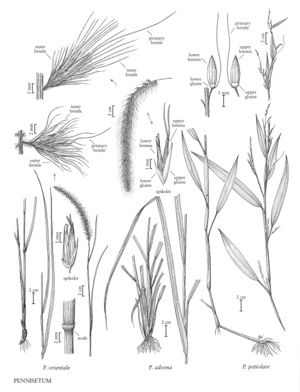Difference between revisions of "Pennisetum orientale"
FNA>Volume Importer |
imported>Volume Importer |
||
| (8 intermediate revisions by 2 users not shown) | |||
| Line 17: | Line 17: | ||
-->{{Treatment/Body | -->{{Treatment/Body | ||
|distribution=Tex. | |distribution=Tex. | ||
| − | |discussion=<p>Pennisetum orientale is native from North Africa to India. It is grown as an ornamental in the Flora region, but has potential as a forage species.</p> | + | |discussion=<p><i>Pennisetum orientale</i> is native from North Africa to India. It is grown as an ornamental in the Flora region, but has potential as a forage species.</p> |
|tables= | |tables= | ||
|references= | |references= | ||
| Line 26: | Line 26: | ||
-->{{#Taxon: | -->{{#Taxon: | ||
name=Pennisetum orientale | name=Pennisetum orientale | ||
| − | |||
|authority=Willd. ex Rich. | |authority=Willd. ex Rich. | ||
|rank=species | |rank=species | ||
| Line 33: | Line 32: | ||
|basionyms= | |basionyms= | ||
|family=Poaceae | |family=Poaceae | ||
| + | |illustrator=Linda A. Vorobik | ||
| + | |illustration copyright=Utah State University | ||
|distribution=Tex. | |distribution=Tex. | ||
|reference=None | |reference=None | ||
| Line 38: | Line 39: | ||
|publication year= | |publication year= | ||
|special status= | |special status= | ||
| − | |source xml=https:// | + | |source xml=https://bitbucket.org/aafc-mbb/fna-data-curation/src/200273ad09963decb8fc72550212de541d86569d/coarse_grained_fna_xml/V25/V25_1367.xml |
|subfamily=Poaceae subfam. Panicoideae | |subfamily=Poaceae subfam. Panicoideae | ||
|tribe=Poaceae tribe Paniceae | |tribe=Poaceae tribe Paniceae | ||
Latest revision as of 18:56, 11 May 2021
Plants perennial; rhizomatous. Culms 50-200 cm, erect, pubescent beneath the panicle; nodes pubescent. Leaves green or glaucous; sheaths antrorsely scabridulous, mostly glabrous, margins ciliate; ligules 1-1.7 mm; blades 25-50 cm long, 3-9 mm wide, flat, antrorsely scabridulous, glabrous or pubescent, margins ciliate or glabrous basally, midvein not noticeably thickened. Panicles 11.5-37.3 cm long, 35-50 mm wide, fully exerted from the sheaths, erect to slightly arching, white (sometimes purplish-tinged); rachises terete, pubescent. Fascicles 5-12 per cm; fascicle axes 1-6 mm, with 1-10 spikelets; outer bristles 0-24, 0.8-9.6 mm, terete, scabrous; inner bristles 6-20, 5.6-17.5 mm, ciliate; primary bristles 12.2-23.8 mm, ciliate, noticeably longer than the other bristles. Spikelets 5.6-6.7 mm; pedicels 0.1-0.2 mm; lower glumes 1-2.2 mm, veinless; upper glumes 3.1-5.5 mm, 1-3-veined; lower florets staminate; lower lemmas 5.2-6.5 mm, 4-6-veined; lower paleas 3.8-5 mm; anthers 2.3-3 mm; upper florets not disarticulating at maturity; upper lemmas 5.2-6.2 mm, margins glabrous, 5-veined; upper paleas bifid, teeth 0.3-0.8 mm; anthers 1.9-2.9 mm. Caryopses concealed by the lemma and palea at maturity. 2n = 18, 27, 36, 45, 54.
Distribution
Tex.
Discussion
Pennisetum orientale is native from North Africa to India. It is grown as an ornamental in the Flora region, but has potential as a forage species.
Selected References
None.
